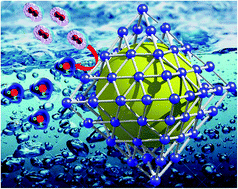Single-layered platinum nanocage: a highly selective and efficient catalyst for fuel cells†
Abstract
Developing a highly efficient catalyst for the oxygen reduction reaction (ORR) is key to the performance of fuel cells for future energy applications. ORR pathways are systematically studied on the (111) facet of an octahedral single-layered platinum nanocage (Pt66), enclosed by well-defined (111) facets. Energetic (cohesive energy), thermal (molecular dynamics simulation) and dynamic (phonon frequency) calculations are carried out to evaluate the stability of the nanocage. Thermodynamic (reaction free energies) and kinetic (free energy barriers, and temperature dependent reaction rates) parameters are investigated to find out the most favourable pathway for the ORR. The catalytic activity of the nanocage is investigated in greater detail toward its product selectivity (H2O vs. H2O2). Previous theoretical and experimental reports on bulk Pt(111) show that direct O–O bond dissociation and OH formation are very much unlikely due to the high-energy barrier. However, we find that the direct O–O bond dissociation and OH formation are thermodynamically and kinetically favourable when catalysed by an octahedral Pt-nanocage. Our microkinetic analysis shows that the nanocage is a highly selective catalyst for the four-electron reduction (*H2O formation) over two-electron reduction (*H2O2 formation). The excellent catalytic activity of the nanocage is explained from the surface energy, compressive strain, Bader charge and density of states analysis.


 Please wait while we load your content...
Please wait while we load your content...